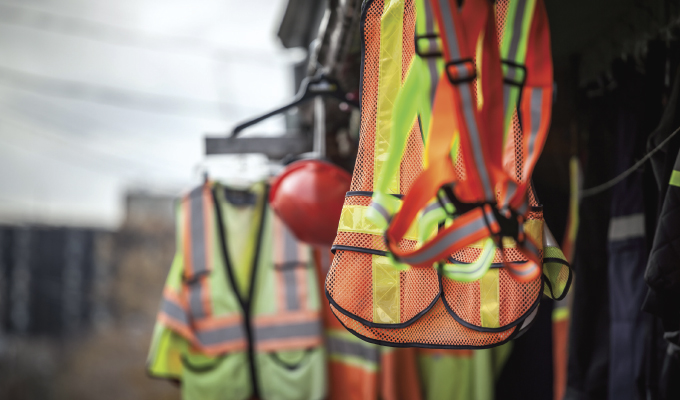Almost any job in the construction industry comes with its share of risk. On the average jobsite, you’ll find multi-ton machines and construction materials moving nimbly from place to place with workers mere feet from them. It’s a recipe for danger that’s unlike anything you’d find in any other profession.
Is it any wonder, then, that construction work is one of the most dangerous professions in the United States? According to the U.S. Bureau of Labor Statistics, almost one in five workplace deaths in 2021 happened in the construction industry. That’s despite stricter-than-ever workplace safety rules and an industry-wide effort to improve site safety.
However, construction professionals don’t have to be at the mercy of the statistics. They have the power to improve site safety on their own by adhering to a few simple best practices. If you’re among them, here are six ways for you to improve site safety.
1. ADHERE TO ALL PPE GUIDELINES
The most important thing that construction professionals can do to improve site safety is to adhere to all applicable personal protective equipment (PPE) guidelines. There are minimum PPE standards set by the OSHA that all construction professionals should familiarize themselves with. Knowing those guidelines improves your ability to keep yourself and others on your jobsite as safe as possible.
2. EVALUATE SITE CONDITIONS FOR MAXIMUM SITUATIONAL AWARENESS
It’s also a good idea for construction professionals to get in the habit of familiarizing themselves with potential danger areas within every jobsite they frequent. This helps provide the situational awareness necessary to avoid undue risk and navigate on-site dangers appropriately. Combined with the benefits of proper PPE usage, this is one of the most proactive steps any construction professional can take to improve their own safety. Plus, it has a knock-on effect of improving the safety of everyone on the site because situationally aware workers will often spot and defuse hazards before they cause accidents for others.
3. UNDERSTAND THE MOST COMMON ACCIDENT TYPES
As a construction professional, you must also get to know the most common types of accidents that occur on construction sites. By doing that, you can more readily identify parts of your jobsite and task types that could involve elevated risk. According to OSHA, a full 60% of all jobsite accidents involve four specific circumstances: falls, electrocutions, getting struck by falling objects, and getting caught between or in objects. Knowing these, you can take extra precautions to avoid bad outcomes. Also, you can get to know the prescribed safety measures that your employer needs to have in place to prevent those types of accidents.
4. UNDERSTAND AND GAME PLAN FOR EMERGENCY RESPONSE
It’s also worth knowing that some of the worst accidents on construction sites occur when workers don’t know how to respond to emergencies. Therefore, to protect yourself and those around you, it’s a good idea to understand your site’s emergency response plan. It should detail where you should go and what you’re expected to do during various types of emergencies. Once you’ve read up on those plans, you should perform a quick walk-through to make certain you have no questions about what to do in an emergency. This will help you react promptly and avoid panic if you need to execute the emergency plan.
5. FOLLOW EQUIPMENT CHECKOUT PROCEDURES
Another way for you to improve site safety is to make it a habit to scrupulously follow all equipment checkout procedures before commencing work. Faulty equipment poses a major danger in the construction industry. However, it’s a danger that you can all but eliminate by checking your equipment for flaws or damage before you use it. Doing so allows you to spot defects before they turn into failures that might cause an injury. Plus, it’ll improve overall site efficiency by cutting down on work stoppages related to equipment malfunctions.
6. NEVER HESITATE TO FILE A COMPLAINT
The final—and arguably most important—thing you can do to improve site safety as a construction professional is to file safety complaints when warranted. Your right to do this is absolute, and you should never hesitate to take this step when your employer isn’t following all applicable safety regulations. And if you fear retaliation, you should know that safety whistleblowers qualify for protected labor status under OSHA regulations.
OSHA even revamped the whistleblower intake process as of the beginning of 2023 to speed up the processing of retaliation complaints. That means you don’t have to fear long-lasting career damage if you file a safety complaint. Nor do you have to fear an endless amount of bureaucratic red tape preventing you from attaining protection from retaliation. In other words, the complaint process gives you the means to force your employer to follow safety guidelines at minimum risk to your own standing.
CLOSING THOUGHT
By making yourself an active participant in improving site safety, you’ll be helping yourself and others to build thriving construction careers without fearing a life- or livelihood-threatening injury. Plus, you’ll help your employer run an ordered and efficient jobsite where work gets done as fast as safely possible. This is a role that every construction professional must play if the construction industry, writ large, is to improve on its historically dismal safety record.
About the Author:

Robin Kix is currently the renewal department manager. Since joining Lance Surety in 2014, she has helped thousands of businesses throughout the nation remain compliant at the federal, state, and local level. She has significant experience supporting commercial bond lines, particularly in the automobile, transportation, and construction industries. For more, visit www.suretybonds.org.
Modern Contractor Solutions, August 2023
Did you enjoy this article?
Subscribe to the FREE Digital Edition of Modern Contractor Solutions magazine.



